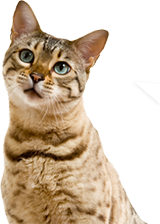Body Language in Dogs
Below you'll find a variety of resources from reputable authors and organizations to help you understand how dogs communicate with us using their entire body. Once you're aware of the subtle and not-so-subtle cues they give, you'll see your dog in a whole new light!
- Body Language of Fear in Dogs
- The Spectrum of Fear, Anxiety & Stress
- Body Language: Do you know what your dog is saying?
- Canine Body Language
Body Language of Fear in Dogs
Dr. Sophia yin, DVM, MS
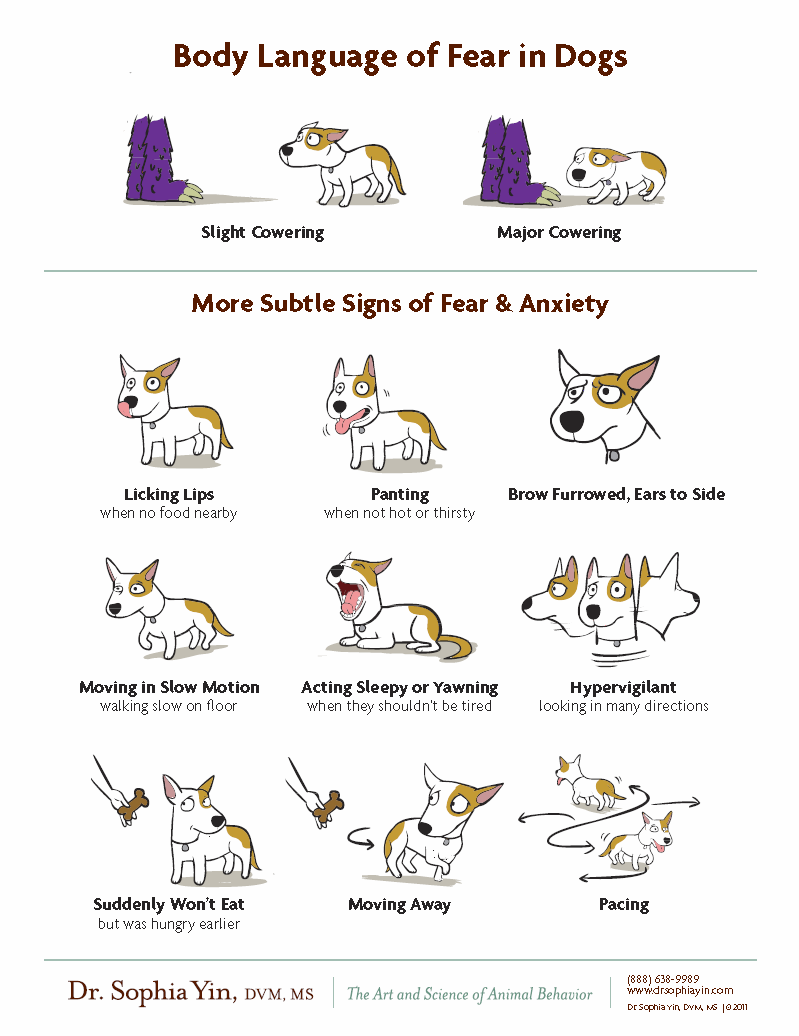
The Spectrum of Fear, Anxiety & Stress
Fear Free Happy Homes
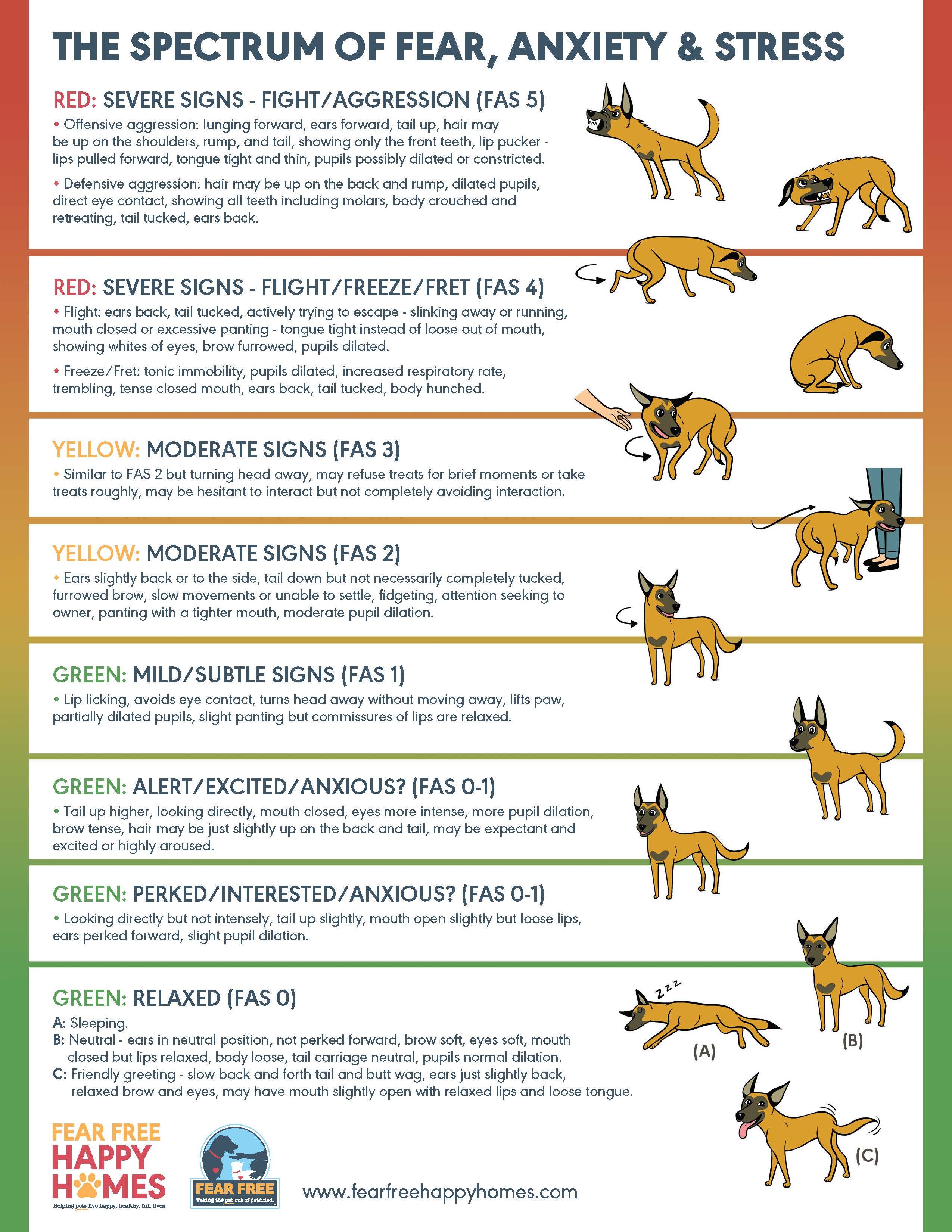
Body Language: Do you know what your dog is saying?
By Colleen Pelar, CPDT, CDBC www.livingwithkidsanddogs.com
Recognizing some common canine stress signals makes supervising the interactions much easier. If your dog shows one of these signals, it is time to intervene and suggest an alternate activity. Just because your dog is showing signs of stress, doesn’t mean that she’s on the verge of aggression. But all behavior deteriorates under stress – our own and our dog’s – so it is important for us to be able to recognize when our dogs need a little help.
Remember that you need to analyze not only your intention, but also the dog’s perception of every interaction. For example, hugs are intended kindly, but few dogs enjoy them.

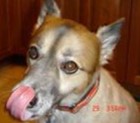 Lip Licking
Lip Licking
When a dog is anxious, she will often quickly stick out her tongue and lick her lips. It’s usually just a fast, little flick. Watch your dog; this is one of the most common signals.
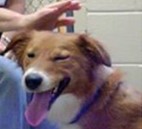 Yawning
Yawning
This is often mistaken for contentment. The dog is surrounded by kids, and she lets out a big yawn. Isn’t that sweet? Nope, it’s a sign that she’s in over her head and would appreciate your help.
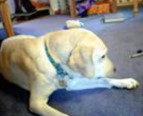 Turning Away
Turning Away
Often guardians think a dog turning away is “blowing them off” and they intensify their demands on her, which is exactly what the dog is trying to avoid.
 Shaking Off
Shaking Off
Compare this to a kind of reset button. The dog is doing a full-body shake-off, as if she were wet. It often happens just after a stressful interaction. Pay attention. It happens more often than you might think. Reboot!
 Half-Moon Eye
Half-Moon Eye
When a dog is calm and relaxed, you don’t usually see much white around her eyes. The “half-moon” refers to the white arc that is often seen when a dog is stressed and trying to hold it in. (Also referred to as “whale eye”)
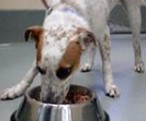 Freezing
Freezing
Watch out! Dogs typically freeze right before they snap or bite.
Back To TopCanine Body Language
ASPCAPro.org
When you think about how dogs communicate, what first comes to mind? Maybe you watch for a wagging tail? Dogs communicate with one another and with us using their own elegant, nonverbal language. They use so much more than just their tails (though tails are important!) Dogs also use facial expressions, ear positions and overall body posture to signal their intentions. Breaking body language down one body part at a time can be helpful in building your observation and interpretation skills. It is vitally important to consider the whole body and the context though, in order to truly “hear” what a dog is saying. Then you can watch the dogs in your life and start to learn what they’re telling you.
 Eyes
Eyes
When looking at dog’s eyes, pay attention to the white part of the eye (the sclera), and consider the focus and intensity of the dog’s gaze. When a dog is feeling tense, his eyes may appear rounder than normal, or they may show a lot of white around the outside (sometimes known as a “whale eye,” as shown by Photo A.) Dilated pupils can also be a sign of fear or arousal – these can make the eyes look “glassy.” These signs indicate that a dog is feeling threatened, stressed or frightened.
A relaxed dog will often squint, so that his eyes become almond-shaped with no white showing at all, like this Labrador in Photo B.
 Mouth
Mouth
A relaxed dog like this Labrador will likely have his mouth open and may be panting, with no facial or mouth tension. The corners of his mouth may be turned upward slightly.
A fearful or tense dog will generally keep his mouth closed, and may pull his lips back at the corners (also known as a “long lip”.) He may also be panting rapidly. A panting dog who suddenly closes his mouth in response to something in the environment may also be indicating increased stress. Drooling when no food is present can also be a sign of extreme fear or stress.
A dog displaying a physical warning may start to wrinkle the top of his muzzle, often next pulling his lips up vertically to display his front teeth. This Doberman in Photo C is displaying this behavior, called an “offensive pucker,” while standing over a bone. Her muzzle is wrinkled and the corner of her mouth is short and forms a C shape. This warning often comes with a tense forehead, hard eyes (note her round eyes with a lot of white showing, and the fully dilated pupil). This dog was also growling when the photo was taken – all very clear warnings to anyone approaching that bone.
Some dogs display a “submissive grin” or “smile”. This is also a gesture where a dog shows his front teeth, but a smiling dog is doing just that. He usually shows a lowered head, wagging tail, flattened ears, a soft body posture and soft, squinty eyes along with those teeth. In Photo D, the same Doberman smiling as she dances around greeting her favorite person – note the softness of her almond-shaped eyes, with no glassiness and no white showing at all. Teeth don’t always mean aggression – it is important to consider the whole body and the context to understand what a dog is saying.
Yawning and lip licking may be an early sign of stress, particularly when accompanied by a tight mouth and often a whining sound, as this dog is doing in Photo E. (She is being approached by a new, strange dog.)
Ears
Dogs have a wide variety of ear types. Although it may be easier for us to see ear position in dogs with erect ears, even floppy-eared dogs like Basset hounds can move the base of their ears forward and back to show different emotions – just look at the direction of the base of the ear. When a dog is relaxed, his ears may be slightly back or out to the sides (Photo F). As a dog becomes more aroused, the ears will move forward, pointing toward a subject of interest. When their ears are most forward their foreheads often wrinkle (Photo G).
Tail
When observing a dog’s tail, there are two things to consider: the position of the base of the tail, and how the tail is moving. A relaxed dog holds his tail in a neutral position, extending out from the spine (Photo I), or may be below spine level. The movement may be a loose wag from side to side or a sweeping circular motion. As the dog become more excited or aroused, his tail usually rises above spine level, as Picture J shows. As he becomes more aroused, the dog may hold his tail high with little movement, or he may move his tail side to side in short, rapid movements.
A fearful dog will tuck his tail between his rear legs, as Photo H shows. The tail may also be held rigid against the belly, or wag stiffly.
Hair
Much like your own “goose bumps,” the hair can raise along a dog’s back when he is upset or aroused. This is also known as piloerection or “raised hackles” and can occur across the shoulders, down the spine, and above the tail. Hackles don’t always mean aggression is imminent, but they are an indicator that the dog is excited or upset about something. A frightened or stressed dog may also shed more than usual.
Sweat
Dogs pant to cool themselves, but panting can also be a sign of stress, particularly rapid panting accompanied by a tight mouth with stress wrinkles around it. Dogs also have the ability to sweat through their paws. You may notice a dog leaving wet footprints on the floor if he is particularly upset.
Overall Body Posture and Body Movement
When initiating play, dogs often start with a play bow, as shown in Photo L, and generally follow up with exaggerated facial and body movements. A playful dog’s body movement will be loose and wiggly, with lots of movement and brief pauses during play. A dog who seems stiff, moves slowly, or who keeps moving away may not be interested in social interaction with this playful dog. Looking away, sniffing, scratching, lying down, or other avoidance behaviors may also indicate that the play session is over.
A fearful dog may lean away, lean back, tremble, crouch, lower his body or head, or roll onto his side or back. Often, his eyes will often be fully open with large pupils, his forehead will be wrinkled, and his tail will be lowered or tucked. An extremely fearful dog may freeze completely or frantically try to escape, and he may urinate or defecate when approached. A dog displaying aggressive body language will look large, standing with his head raised above his shoulders. His body will be tense, with weight either centered or over all four feet or leaning slightly forward onto the front legs. He may also have a wrinkled muzzle, a short lip and a hard eye. Perhaps you can take what you’ve learned here to the dog park and try to spot some of these signals and behaviors. Pay close attention to what comes before, during and after each one. How will this new knowledge enable you to better meet the needs of the dogs in your life?












